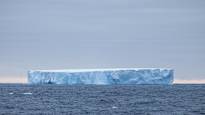Iceberg A23A drifts in the South Atlantic towards the island of South Georgia. The iceberg, which had been in place for decades, started moving with the sea currents just over a year ago.
The world’s largest iceberg threatens to crash into an island populated by penguins and seals in the South Atlantic.
An iceberg called A23A was born in 1986 when it broke off from Antarctica. Then for decades it froze in place on the seabed.
At the end of 2023, the iceberg broke off from the seabed and began to drift north with the sea currents. Now the iceberg is less than 300 kilometers from the island of South Georgia, which is located about 1,800 kilometers from the tip of the South American continent.
Jäävuori has an area of approximately 3,500 square kilometers, larger than the city of Mikkeli. The maximum height of the iceberg is 400 meters, which is almost the same as the Empire State Building in New York.
A23A is also one of the oldest icebergs in the world.
An iceberg can kill animals
The island of South Georgia is part of British-ruled territory. The island’s only human inhabitants are researchers at a British-owned research station.
More wild animals live on the island than people. There are, for example, many different species of penguins, seals and albatrosses. It is also home to the South Georgia wasp, a species of sparrow found nowhere else.
The iceberg raises concerns about the fate of animals. According to the British Broadcasting Company BBC the icebergs have previously killed countless birds and seals on the island, as they have hindered their food supply.
For example, in 2004, an iceberg called A38 washed up on the shores of South Georgia Island, killing penguins and seals when they were no longer able to reach places where they had previously obtained food.
Marine ecologist Mark Belchier however, points out in the BBC article that animal species also have the ability to adapt to changes.
The iceberg moves with the ocean currents to warmer waters and melts. It will probably break into smaller pieces one day. However, the iceberg or part of it is likely to exist for years.
Climate change is not really believed to have anything to do with the movements of the A23A iceberg. However, global warming may cause icebergs to break away from Antarctica more often.
Researchers follow the iceberg’s journey and melting closely. In terms of marine nature, it is also interesting that nutrients are released from the iceberg during melting, which fertilize the marine phytoplankton.
